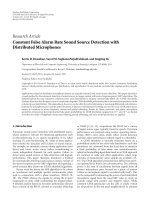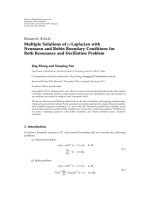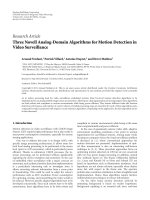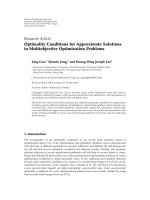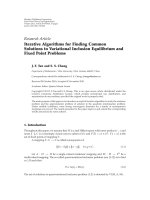Báo cáo hóa học: " Research Article Three Solutions for Forced Duffing-Type Equations with Damping Term" docx
Bạn đang xem bản rút gọn của tài liệu. Xem và tải ngay bản đầy đủ của tài liệu tại đây (503.22 KB, 11 trang )
Hindawi Publishing Corporation
Boundary Value Problems
Volume 2011, Article ID 736093, 11 pages
doi:10.1155/2011/736093
Research Article
Three Solutions for Forced Duffing-Type
Equations with Damping Term
Yongkun Li and Tianwei Zhang
Department of Mathematics, Yunnan University, Kunming, Yunnan 650091, China
Correspondence should be addressed to Yongkun Li,
Received 16 December 2010; Revised 6 February 2011; Accepted 11 February 2011
Academic Editor: Dumitru Motreanu
Copyright q 2011 Y. Li and T. Zhang. This is an open access article distributed under the Creative
Commons Attribution License, which permits unrestricted use, distribution, and reproduction in
any medium, provided the original work is properly cited.
Using the variational principle of Ricceri and a local mountain pass lemma, we study the existence
of three distinct solutions for the following resonant Duffing-type equations with damping and
perturbed term u
tσu
tft, ut λgt, ut pt,a.e.t ∈ 0,ω, u00 uω and
without perturbed term u
tσu
tft, ut pt,a.e.t ∈ 0,ω, u00 uω.
1. Introduction
In this paper, we consider the following resonant Duffing-type equations with damping and
perturbed term:
u
σu
t
f
t, u
t
λg
t, u
t
p
t
, a.e.t∈
0,ω
,
u
0
0 u
ω
,
1.1
where σ,λ ∈ R, f, g : 0,ω × R → R,andp : 0,ω → R are continuous. Letting λ 0in
problem 1.1 leads to
u
t
σu
t
f
t, u
t
p
t
, a.e.t∈
0,ω
,
u
0
0 u
ω
,
1.2
whichisacommonDuffing-type equation without perturbation.
The Duffing equation has been used to model the nonlinear dynamics of special types
of mechanical and electrical systems. This differential equation has been named after the
2 Boundary Value Problems
studies of Duffing in 1918 1, has a cubic nonlinearity, and describes an oscillator. It is
the simplest oscillator displaying catastrophic jumps of amplitude and phase when the
frequency of the forcing term is taken as a gradually changing parameter. It has drawn
extensive attention due to the richness of its chaotic behaviour with a variety of interesting
bifurcations, torus and Arnolds tongues. The main applications have been in electronics, but
it can also have applications in mechanics and in biology. For example, the brain is full of
oscillators at micro and macro levels 2. There are applications in neurology, ecology, secure
communications, cryptography, chaotic synchronization, and so on. Due to the rich behaviour
of these equations, recently there have been also several studies on the synchronization of
two coupled Duffing equations 3, 4. The most general forced form of the Duffing-type
equation is
u
t
σu
t
f
t, u
t
p
t
. 1.3
Recently, many authors have studied the existence of periodic solutions of the Duffing-type
equation 1.3. By using various methods and techniques, such as polar coor dinates, the
method of upper and lower solutions and coincidence degree theory and a series of existence
results of nontrivial solutions for the Duffing-type equations such as 1.3 have been obtained;
we refer to 5–11 and references therein. There are also authors who studied the Duffing-type
equations by using the critical point theory see 12, 13.In12, by using a saddle point
theorem, Tomiczek obtained the existence of a solution of the following Duffing-type system:
u
t
σu
t
m
2
−
σ
2
4
u
t
f
t, u
t
p
t
, a.e.t∈
0,ω
,
u
0
0 u
ω
,
1.4
which is a special case of problems 1.1-1.2. However, to the best of our knowledge, there
are few results for the existence of multiple solutions of 1.3.
Our aim in this paper is to study the variational structure of problems 1.1-1.2 in
an appropriate space of functions and the existence of solutions for problems 1.1-1.2
by means of some critical point theorems. The organization of this paper is as follows. In
Section 2, we shall study the variational structure of problems 1.1-1.2 and give some
important lemmas which will be used in later section. In Section 3, by applying some critical
point theorems, we establish sufficient conditions for the existence of three distinct solutions
to problems 1.1-1.2.
2. Variational Structure
In the Sobolev space H : H
1
0
0,ω, consider the inner product
u, v
H
ω
0
u
s
v
s
ds ∀u, v ∈ H, 2.1
Boundary Value Problems 3
inducing the norm
u
H
u, v
H
ω
0
u
s
2
ds
1/2
∀u ∈ H.
2.2
We also consider the inner product
u, v
ω
0
e
σs
u
s
v
s
ds ∀u, v ∈ H, 2.3
and the norm
u
u, v
ω
0
e
σs
u
s
2
ds
1/2
∀u ∈ H.
2.4
Obviously, the norm ·and the norm ·
H
are equivalent. So H is a Hilbert space with the
norm ·.
By Poincar
´
e’s inequality,
u
2
2
:
ω
0
|
u
s
|
2
ds ≤
1
λ
1
ω
0
u
s
2
ds
≤
1
λ
1
min
{
1,e
σω
}
ω
0
e
σs
u
s
2
ds : λ
0
u
2
∀u ∈ H,
2.5
where λ
0
: 1/λ
1
min{1,e
σω
}, λ
1
: π
2
/ω
2
is the first eigenvalue of the problem
−u
t
λu
t
,t∈
0,ω
,
u
0
0 u
ω
.
2.6
Usually, in order to find the solution of problems 1.1-1.2, we should consider the
following functional Φ, Ψ defined on H:
Φ
u
1
2
ω
0
e
σs
|u
s
|
2
ds
ω
0
e
σs
p
s
u
s
ds −
ω
0
e
σs
F
s, u
s
ds
Ψ
u
−
ω
0
e
σs
G
s, u
s
ds,
2.7
where Fs, u
u
0
fs, μdμ, Gs, u
u
0
gs, μdμ.
4 Boundary Value Problems
Finding solutions of problem 1.1 is equivalent to finding critical points of I :ΦλΨ
in H and
I
u
,v
ω
0
e
σs
u
s
v
s
ds
ω
0
e
σs
p
s
v
s
ds
−
ω
0
e
σs
f
s, u
v
s
ds −
ω
0
e
σs
λg
s, u
v
s
ds, ∀u, v ∈ H.
2.8
Lemma 2.1 H
¨
older Inequality. Let f, g ∈ Ca, b, p>1,andq the conjugate number of p.Then
b
a
f
s
g
s
ds ≤
b
a
f
s
p
ds
1/p
·
b
a
g
s
q
ds
1/q
.
2.9
Lemma 2.2. Assume the following condition holds.
f1 There exist positive constants α, β,andγ ∈ 0, 1 such that
f
s, x
≤ α β
|
x
|
γ
∀
s, x
∈
0,ω
× R. 2.10
Then Φ is coercive.
Proof. Let {u
n
}
n∈N
⊂ H be a sequence such that lim
n → ∞
u
n
∞. It follows from f1 and
H
¨
older inequality that
Φ
u
n
1
2
ω
0
e
σs
u
n
s
2
ds
ω
0
e
σs
p
s
u
n
s
ds −
ω
0
e
σs
F
s, u
n
s
ds
≥
1
2
u
n
2
−
ω
0
e
2σs
p
s
2
ds
1/2
u
n
2
− max
{
1,e
σω
}
ω
0
α
|
u
n
|
β
|
u
n
|
γ1
ds
≥
1
2
u
n
2
−
ω
0
e
2σs
p
s
2
ds
1/2
u
n
2
− α
√
ω max
{
1,e
σω
}
u
n
2
− β
ω
1−γ
max
{
1,e
σω
}
u
n
γ1
2
≥
1
2
u
n
2
−
λ
0
ω
0
e
2σs
p
s
2
ds
1/2
α
√
ω max
{
1,e
σω
}
u
n
−
λ
γ1
0
β
ω
1−γ
max
{
1,e
σω
}
u
n
γ1
,
2.11
which implies from γ ∈ 0, 1 that lim
n → ∞
Φu
n
∞. This completes the proof.
From the proof of Lemma 2.2, we can show the following Lemma.
Boundary Value Problems 5
Lemma 2.3. Assume that 2βλ
0
max{e
σω
, 1} < 1 and the following condition holds.
f2 There exist positive constants α
0
and β
0
such that
f
s, x
≤ α
0
β
0
|
x
|
∀
s, x
∈
0,ω
× R. 2.12
Then Φ is coercive.
Lemma 2.4. Assume the following condition holds.
f3 lim
|x|→∞
x
0
fs, μdμ ≤ 0 for all s ∈ 0,ω.
Then Φ is coercive.
Proof. Let {u
n
}
n∈N
⊂ H be a sequence such that lim
n → ∞
u
n
∞. Fix >0, from f3,there
exists K K > 0suchthat
F
s, x
≤− ∀s ∈
0,ω
,
|
x
|
>K. 2.13
Denote by {|u|≤K} the set {s ∈ 0,ω : |us|≤K} and by {|u| >K} its complement in
0,ω.Putφ
K
s : sup
|x|≤K
|Fs, x| for all s ∈ 0,ω. By the continuity of f, we know that
sup
s∈0,ω
φ
K
s < ∞. Then one has
Φ
u
n
1
2
ω
0
e
σs
u
n
s
2
ds
ω
0
e
σs
p
s
u
n
s
ds
−
{|
u
n
|
≤K
}
e
σs
F
s, u
n
s
ds −
{
|
u
n
|
>K}
e
σs
F
s, u
n
s
ds
≥
1
2
u
n
2
−
λ
0
ω
0
e
2σs
p
s
2
ds
1/2
u
n
−
ω
0
e
σs
φ
K
s
ds,
2.14
which implies that lim
n →∞
Φu
n
∞. This completes the proof.
Based on Ricceri’s variational principle in 14, 15, Fan and Deng 16 obtained the
following result which is a main tool used in our paper.
Lemma 2.5 see 16. Suppose that D is a bounded convex open subset of H, v
1
,v
2
∈ D, Φv
1
inf
D
Φc
0
, inf
∂D
Φb>c
0
, v
2
is a strict local minimizer of Φ,andΦv
2
c
1
>c
0
.Then,for
>0 small enough and any ρ
2
>c
1
, ρ
1
∈ c
0
, min {b, c
1
},thereexistsλ
∗
> 0 such that for each
λ ∈ 0,λ
∗
, ΦλΨ has at least two local minima u
1
and u
2
lying in D,whereu
1
∈ Φ
−1
−∞,ρ
0
∩D,
u
2
∈ Φ
−1
−∞,ρ
1
∩Bu
1
,,whereBu
1
,{u ∈ H : u −u
1
<},andu
2
∈ Bu
1
,.
3. Main Results
In this section, we will prove that problems 1.1-1.2 have three distinct solutions by using
the variational principle of Ricceri and a local mountain pass lemma.
6 Boundary Value Problems
Theorem 3.1. Assume that (f1) holds. Suppose further that
f4 there exists δ>0 such that
x
2
2λ
0
e
σs
p
s
x>
x
0
f
s, μ
dμ ∀
s, x
∈
0,ω
×
−δ, 0
∪
0,δ
,
3.1
f5 there exists x
0
∈ H such that Φx
0
< 0.
Then there exist λ
∗
> 0 and r>0 such that, for every λ ∈ −λ
∗
,λ
∗
,problem1.1 admits at least
three distinct solutions which belong to B0,r ⊆ H.
Proof. By Lemma 2.2, condition f1 implies that the functional Φ is coercive. Since Φ is
sequentially weakly lower semicontinuous see 16, Propositions 2.5 and 2.6, Φ has a global
minimizer v
1
.Byf5,weobtainΦv
1
inf
H
Φc
0
< 0. Let D : B0,η{u ∈ H : u <η}.
Since Φ is coercive, we can choose a large enough η such that
v
1
∈ D, Φ
v
1
inf
D
Φc
0
< 0, inf
∂D
Φb>0 >c
0
.
3.2
Now we prove that Φ has a strict local minimum at v
2
0. By the compact embedding
of H into C0,ω; R,thereexistsaconstantc
1
> 0suchthat
max
s∈0,ω
|
u
s
|
≤ c
1
u
∀u ∈ H.
3.3
Choosing r
δ
<δ/c
1
, it results that
B
0,r
δ
{
u ∈ H :
u
≤ r
δ
}
⊆
u ∈ H :max
s∈0,ω
|
u
s
|
<δ
.
3.4
Therefore, for every u ∈ B0,r
δ
\{0}, it follows from f4 that
Φ
u
1
2
ω
0
e
σs
u
s
2
ds
ω
0
e
σs
p
s
u
s
ds −
ω
0
e
σs
F
s, u
s
ds
≥
1
2λ
0
ω
0
|
u
s
|
2
ds
ω
0
e
σs
p
s
u
s
ds −
ω
0
e
σs
F
s, u
s
ds
ω
0
e
σs
|
u
s
|
2
2λ
0
e
σs
p
s
u
s
− F
s, u
s
ds
> Φ
0
0,
3.5
which implies that v
2
0 is a strict local minimum of Φ in H with c
1
:Φv
2
0 >c
0
.
At this point, we can apply Lemma 2.5 taking Ψ and −Ψ as perturbing terms. Then,
for ∈ 0,r
δ
small enough and any ρ
1
∈ c
0
, min {b, c
1
}, ρ
2
∈ 0, ∞, we can obtain the
following.
Boundary Value Problems 7
i There exists
λ>0suchthat,foreachλ ∈ −
λ,
λ, ΦλΨ has two distinct local
minima u
1
and u
2
satisfying
u
1
∈ Φ
−1
−∞,ρ
1
,u
2
∈ Φ
−1
−∞,ρ
2
∩ B
0,
.
3.6
ii θ : inf
u
Φu > 0 see 16,Theorem3.6
Let r
1
> 0besuchthat
Φ
−1
−∞,ρ
1
∪ B
0,
⊆ B
0,r
1
,
3.7
and put b sup
u≤r
1
|Φu|. Owing to the coerciveness of Φ,thereexistsr
2
>r
1
such that
inf
ur
2
Φud>b.Sinceg : 0,ω × R → R is continuous, then
sup
u
≤r
2
|
Ψ
u
|
< ∞.
3.8
Choosing λ<d −b/2sup
u≤r
2
|Ψu|, hence, for every u ∈ H with u r
2
, one has
Φ
u
λΨ
u
≥ d −
|
λ
|
sup
u
≤r
2
|
Ψ
u
|
>
b d
2
,
3.9
and when u≤r
1
Φ
u
λΨ
u
≤ b
|
λ
|
sup
u
≤r
2
|
Ψ
u
|
<b
d −b
2
:
d b
2
.
3.10
Further, from 3.6,wehavethat−∞ < Φu
2
<ρ
2
.Sinceρ
2
∈ 0, ∞ is arbitrary, letting
ρ
2
: θ/4 > 0, we can obtain that
Φ
u
2
<
θ
4
.
3.11
Therefore, by 3.6 and 3.11,
λ can be chosen small enough that
Φ
u
1
λΨ
u
1
≤ 0, Φ
u
2
λΨ
u
2
<
θ
2
, inf
u
Φ
u
λΨ
u
≥
θ
2
,
3.12
and 3.9-3.10 hold, for every λ ∈ −
λ,
λ.
8 Boundary Value Problems
For a given λ in the interval above, define the set of paths going from u
1
to u
2
A
ϕ ∈ C
0, 1
,H
: ϕ
0
u
1
,ϕ
1
u
2
, 3.13
and consider the real number c : inf
ϕ∈A
sup
s∈0,1
Φϕs λΨϕs.Sinceu
1
∈B0, and
each path ϕ goes through ∂B0,, one has c ≥ θ/2.
By 3.9 and 3.10, in the definition of c, there is no need to consider the paths going
through ∂B0,r
2
. Hence, there exists a sequence of paths {ϕ
n
}⊂Asuch that ϕ
n
0, 1 ⊂
B0,r
2
and
sup
s∈0,1
Φ
ϕ
n
s
λΨ
ϕ
n
s
−→ c as n −→ ∞.
3.14
Applying a general mountain pass lemma without the PS condition see 17,Theorem2.8,
there exists a sequence {u
n
}⊂B0,r
2
such that Φu
n
λΨu
n
→ c and Φ
u
n
λΨ
u
n
→
0asn → ∞.Hence{u
n
} is a bounded PS
c
sequence and, taking into account the fact that
Φ
λΨ
is an S
type mapping, admits a convergent subsequence t o some u
3
.So,suchu
3
turns to be a critical point of ΦλΨ,withΦu
3
λΨu
3
c,hencedifferent from u
1
and u
2
and u
3
/
0. This completes the proof.
Taking λ 0inTheorem 3.1, w e can obtain the existence of three distinct solutions for
the Duffing-type equation without perturbation 1.2 as following.
Theorem 3.2. Assume that (f1), (f4), and ( f5) hold; then problem 1.2 admits at least three distinct
solutions.
Together with Lemma 2.3 and Lemma 2.4, we can easily show that the following
corollary.
Corollary 3.3. Assume that (f2), (f4), and (f5) h old; then there exist λ
∗
> 0 and r>0 such that, for
every λ ∈ −λ
∗
,λ
∗
,problem1.1 admits at least three distinct solutions which belong to B0,r ⊆ H.
Furthermore, problem 1.2 admits at least three distinct solutions.
Corollary 3.4. Assume that (f3), (f4), and (f5); hold, then there exist λ
∗
> 0 and r>0 such that, for
every λ ∈ −λ
∗
,λ
∗
,problem1.1 admits at least three distinct solutions which belong to B0,r ⊆ H.
Furthermore, problem 1.2 admits at least three distinct solutions.
4. Some Examples
Example 4.1. Consider the following r esonant Duffing-type equations with damping and
perturbed term
u
t
σu
t
f
t, u
t
λg
t, u
t
p
t
, a.e.t∈
0, 2π
,
u
0
0 u
2π
,
4.1
Boundary Value Problems 9
where σ 1, λ ∈ R, gs, xsx
4
, ps20 cos
2
s,and
f
t, x
⎧
⎪
⎪
⎪
⎪
⎪
⎪
⎪
⎪
⎪
⎪
⎪
⎪
⎨
⎪
⎪
⎪
⎪
⎪
⎪
⎪
⎪
⎪
⎪
⎪
⎪
⎩
20 cos
2
s x
1/3
for
s, x
∈
0, 2π
×
−∞, −1
,
20 cos
2
s Q
1
x
for
s, x
∈
0, 2π
×
−1, −0.001
,
20 cos
2
s − x
1/3
for
s, x
∈
0, 2π
×
−0.001, 0.001
,
20 cos
2
s Q
2
x
for
s, x
∈
0, 2π
×
0.001, 1
,
20 cos
2
s x
1/3
for
s, x
∈
0, 2π
×
1, ∞
,
4.2
in which Q
1
∈ C−1, −0.001 and Q
2
∈ C 0.001, 1 satisfy
Q
1
−1
−1 , Q
1
−0.001
0.1,Q
2
0.001
−0.1,Q
2
1
1,
1
0.001
Q
2
s
ds>1.
4.3
Then there exists λ
∗
> 0, for every λ ∈ −λ
∗
,λ
∗
,problem8 admits at least three distinct
solutions.
Proof. Obviously, from the definitions of Q
1
and Q
2
, it is easy to see that f : 0,ω × R → R
is continuous and f1 holds. Taking δ 0.001, for s, x ∈ 0, 2π ×−0.001, 0 ∪0, 0.001,we
have that
x
2
2λ
0
e
σs
p
s
x −
x
0
f
s, μ
dμ ≥
x
2
8e
2π
20
cos
2
s
x −
20
cos
2
s
x −
3
4
x
4/3
x
2
8e
2π
3
4
x
4/3
> 0,
4.4
which implies that f4 is satisfied. Define
x
0
s
⎧
⎪
⎪
⎪
⎪
⎨
⎪
⎪
⎪
⎪
⎩
0, for s 0,
10
4
sin s, for s ∈
0, 2π
,
0, for s 2π.
4.5
10 Boundary Value Problems
Clearly, x
0
∈ H.Thenweobtainthat
Φ
x
0
s
1
2
2π
0
e
s
cos
2
s ds 20 cos
2
t
2π
0
e
s
10
4
sin s
ds
−
2π
0
e
s
0.001
0
1
0.001
10
4
sin s
1
f
s,μ
dμ ds
e
2π
π
2
2π
0
e
s
0.001
0
μ
1/3
dμ ds
−
2π
0
e
s
1
0.001
Q
2
μ
dμ ds −
2π
0
e
s
10
4
sin s
1
μ
1/3
dμ ds
≤
e
2π
π
2
− 10
4
< 0.
4.6
So Φx
0
< 0, which implies that f5 is satisfied. To this end, all assumptions of Theorem 3.1
hold. By Theorem 3.1,thereexistsλ
∗
> 0, for every λ ∈ −λ
∗
,λ
∗
,problem8 admits at least
three distinct solutions.
Example 4 .2. Let λ 0. From Example 4.1, we can obtain that the following resonant Duffing-
type equations with damping:
u
t
u
t
100e
2π
√
x 10, a.e.t∈
0, 2π
,
u
0
0 u
2π
4.7
admits at least three distinct solutions.
Acknowledgment
This work is supported by the National Natural Sciences Foundation of People’s Republic of
China under Grant no. 10971183.
References
1 G. Duffing, “Erzwungene Schwingungen bei ver
¨
anderlicher Eigenfrequenz und ihre Technische
Beduetung,” Vieweg B raunschweig, 1918.
2 E. C. Zeeman, “Duffing’s equation in brain modelling,” Bulletin of the Institute of Mathematics and Its
Applications, vol. 12, no. 7, pp. 207–214, 1976.
3 A. N. Njah and U. E. Vincent, “Chaos synchronization between single and double wells Duffing-Van
der Pol oscillators using active control,” Chaos, Solitons and Fractals, vol. 37, no. 5, pp. 1356–1361, 2008.
4 X. Wu, J. C ai, and M. Wang, “Global chaos synchronization of the parametrically excited Duffing
oscillators by linear state error feedback control,” Chaos, Solitons and Fractals, vol. 36, no. 1, pp. 121–
128, 2008.
Boundary Value Problems 11
5 L. Peng, “Existence and uniqueness of periodic solutions for a kind of Duffing equation with two
deviating arguments,” Mathematical and Computer Modelling, vol. 45, no. 3-4, pp. 378–386, 2007.
6 H. Chen and Y. L i, “Rate of decay of stable periodic solutions of D uffing equations,” Journal of
Differential Equations, vol. 236, no. 2, pp. 493–503, 2007.
7 A. C. Lazer and P. J. McKenna, “On the existence of stable periodic solutions of differential equations
of Duffing type,” Proceedings of the American Mathematical Society, vol. 110, no. 1, pp. 125–133, 1990.
8 B. Du, C. Bai, and X. Zhao, “Problems of periodic solutions for a type of Duffing equation with state-
dependent delay,” Journal of Computational and Applied Mathematics, vol. 233, no. 11, pp. 2807–2813,
2010.
9 Y. Wang and W. Ge, “Periodic solutions for Duffing equations with a p-Laplacian-like operator,”
Computers & Mathematics with Applications, vol. 52, no. 6-7, pp. 1079–1088, 2006.
10 F. I. Njoku and P. Omari, “Stability properties of periodic solutions of a Duffing equation in the
presence of lower and upper solutions,” Applied Mathematics and Computation, vol. 135, no. 2-3, pp.
471–490, 2003.
11 Z.Wang,J.Xia,andD.Zheng,“PeriodicsolutionsofDuffing equations w ith semi-quadratic potential
and singularity,” Journal of Mathematical Analysis and Applications, vol. 321, no. 1, pp. 273–285, 2006.
12 P. Tom i cze k , “T he D u ffing equation with the potential Landesman-Lazer condition,” Nonlinear
Analysis: Theory, Methods & Applications, vol. 70, no. 2, pp. 735–740, 2009.
13 Y. Li and T. Zhang, “On the existence of solutions for impulsive Duffing dynamic equations on time
scales with Dirichlet boundary conditions,” Abstract and Applied Analysis, vol. 2010, Article ID 152460,
27 pages, 2010.
14 B. Ricceri, “A general variational principle and some of its applications,” Journal of Computational and
Applied Mathematics, vol. 113, no. 1-2, pp. 401–410, 2000.
15 B. Ricceri, “Sublevel sets and global minima of coercive functionals and local minima of their
perturbations,” Journal of Nonlinear and Convex Analysis, vol. 5, no. 2, pp. 157–168, 2004.
16 X. Fan and S G. Deng, “Remarks on Ricceri’s variational principle and applications to the px-
Laplacian equations,” Nonlinear Analysis. Theory, Methods & A pplications, vol. 67, no. 11, pp. 3064–3075,
2007.
17 M. Willem, Minimax Theorems,Birkh
¨
auser, Boston, Mass, USA, 1996.



